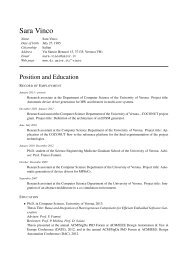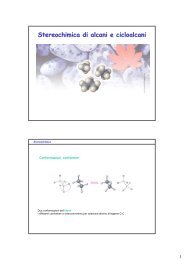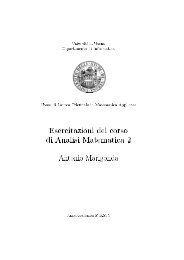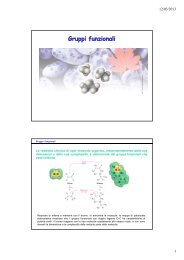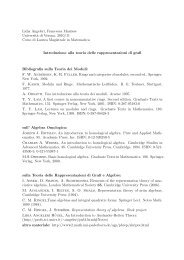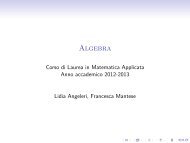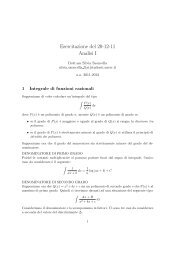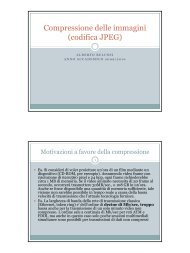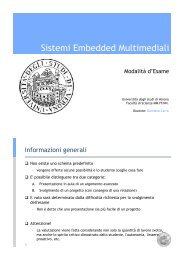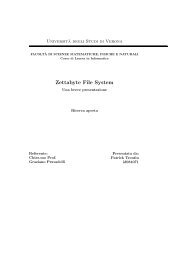116 22. FORME DIFFERENZIALI Quindi V (x, y) = (x 2 + 1)y e la soluzione è data da (x 2 + 1)y = c, c ∈ R. Osserviamo che 1 + x 2 = 0, per cui si può scrivere: L’equazione può essere scr<strong>it</strong>ta nella forma: si ha quindi, integrando, y ′ y y ′ (x) = dy 2xy (x) = − dx x2 + 1 2x = − x2 d = − + 1 dx log(x2 + 1) dy y d = − dx log(x2 + 1) e quindi log |y| = − log(x 2 + 1) + d, al variare di d ∈ R da cui |y| = ed x 2 +1 , quindi y = c x 2 +1 al variare di c ∈ R (si ponga c = ±e d ), che conferma il risultato precedente. (2) la forma è evidentemente chiusa su R 2 . Determiniamo un potenziale integrando tale forma su una spezzata γ che congiunga (0, 0) ad un generico punto (x0, y0) con segmenti paralleli agli assi, γ = γ1∪γ2 dove γ1(x) = (x, 0) per 0 ≤ x ≤ x0 (oppure x0 ≤ x ≤ 0) e γ2(y) = (x0, y) per 0 < y < y0 (oppure y0 ≤ y ≤ 0). V (x0, y0) = = γ x0 0 ω = γ1 ((x 2 + y 2 − 2x) dx + 2xy dy) + (x 2 − 2x) dx + y0 0 γ2 2x0y dy = x3 0 3 − x2 0 + x0y 2 0. ((x 2 + y 2 − 2x) dx + 2xy dy) Quindi V (x, y) = x3 3 − x2 + xy 2 e la soluzione è data da x(x 2 /3 − x + y 2 ) = c, c ∈ R. In R 2 \ {xy = 0} possiamo dividere per 2xy ottenendo y ′ (x) = dy dx = −x2 + y2 − 2x , 2xy ma la risoluzione di tale equazione non appare immediata. (3) posto p(x, y) = y 2 e q(x, y) = xy − 1, si ha ∂yp − ∂xq = 2y − y = y = 0, quindi la forma ω non è chiusa. Tuttavia si può scrivere ∂yp − ∂xq = y = f(x)q(x, y) − g(y)p(x, y) infatti il membro di sinistra è y, e a destra si può scegliere f ≡ 0 e g(y) = −1/y. Allora, scelto ad esempio (x0, y0) = (0, 1) si ha: x y y h(x, y) = exp f(t)dt + g(t)dt = exp − 1 1 t dt = e log(1/y) = 1/y x0 è fattore integrante, defin<strong>it</strong>o su R2 \ {y = 0}. Scriviamo quindi h(x, y)ω(x, y) = y dx + x − 1 dy. y y0 Tale forma è chiusa su ciascuno dei due semipiani H + = {(x, y) : y > 0} e H − = {(x, y) : y < 0}. Tali semipiani sono semplicemente connessi e quindi la forma è ivi esatta. Determiniamo quindi i potenziali V + e V − defin<strong>it</strong>i su H + e H − rispettivamente. A tal propos<strong>it</strong>o, consideriamo un punto di H + , ad esempio (0, 1) e congiungiamolo al generico punto (x0, y0) di H + con una spezzata cost<strong>it</strong>u<strong>it</strong>a da due segmenti paralleli agli assi γ = γ1 ∪ γ2 dove γ1(x) = (x, 0) per 0 ≤ x ≤ x0 (oppure x0 ≤ x ≤ 0) e γ2(y) = (x0, y) per 1 < y < y0 (oppure 0 < y0 ≤ y ≤ 1). V + (x0, y0) = h(x, y)ω(x, y) + h(x, y)ω(x, y) = γ1 γ2 x0 0 y0 dx + x0 − 1 1 dy y = x0 + [x0y − log |y|] y=y0 y=1 = x0 + x0y0 − log y0 − x0 = x0y0 − log y0 Pertanto V + (x, y) = xy − log y, defin<strong>it</strong>o per y > 0 e le soluzioni in H + sono date da V + (x, y) = c, c ∈ R. Determiniamo ora V − . Consideriamo un punto di H − , ad esempio (0, −1) e congiungiamolo al generico punto (x0, y0) di H + con una spezzata cost<strong>it</strong>u<strong>it</strong>a da due segmenti paralleli agli assi γ = γ1 ∪ γ2 dove
22. FORME DIFFERENZIALI 117 γ1(x) = (x, 0) per 0 ≤ x ≤ x0 (oppure x0 ≤ x ≤ 0) e γ2(y) = (x0, y) per −1 < y < y0 < 0 (oppure y0 ≤ y ≤ −1). V − (x0, y0) = h(x, y)ω(x, y) + h(x, y)ω(x, y) = γ1 x0 0 γ2 y0 −1 dx + x0 − −1 1 y = −x0 + [x0y − log |y|] y=y0 y=−1 = x0 + x0y0 − log |y0| + x0 = x0y0 − log |y0| = x0y0 − log(−y0), ricordando che y0 < 0. Pertanto V − (x, y) = xy − log y, defin<strong>it</strong>o per y < 0 e le soluzioni in H − sono date da V − (x, y) = c, c ∈ R. Possiamo raggruppare le due espressioni definendo V (x, y) = xy − log |y| in R 2 \ {y = 0} e le soluzioni in R 2 \ {y = 0} saranno date da xy − log |y| = c, c ∈ R dy



